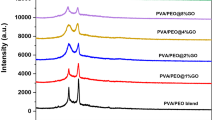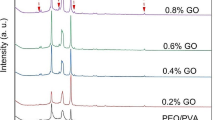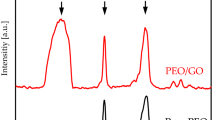Abstract
Our articles describe the casting process for producing polyvinyl alcohol (PVA)/polyethylene oxide (PEO)/graphene nanoplates (GNPTs) nanocomposites' films. The influence of different concentrations (0.0, 0.05, 0.1, 0.5, and 1%) of GNPTs on the structural, optical, electrical, and dielectric properties of PVA/PEO nanocomposites have been investigated by a Fourier transform infrared (FTIR), X-ray diffraction (XRD), UV\vis spectroscopy, and impedance analyzer. The XRD of the nanocomposite films confirms the enhanced degree of amorphously in the PEO/PVA virgin polymer because of the addition of the GNPTs as nanofiller. The crystallinity decreased from 38.34 to 15.72. The FTIR approves the complexations or interaction of the GNPTs with the polymeric matrix. The optical parameters of the direct and indirect energy gap, as well as Urbach energy, were evaluated using UV/vis absorption spectra in the wavelength range of 200–800 nm. The increase in the concentration of GNPTs resulted in a reduction of the optical band gaps, which reached 1.99 eV for allowed indirect transition. The electric conductivity called AC is the electric conductivity originating potential dependent on frequency. Electrical conductivity is the reciprocal of electrical resistivity, and resistivity can be calculated from resistivity = resistance *Area/Length of a specimen. The composites' ac conductivity varies with frequency according to Jonscher's universal power equation, and it is observed to increase with increasing nanofiller concentrations. At room temperature, the sample containing 1 wt% GNPTs has good optical characteristics, high conductivity, and dielectric constant. The dielectric constants (ε′ and ε′′) increased as the nanofiller concentration increased and reduced as the frequency increased. Important enhancement in optical, dielectric, and ac electrical properties in these composite films makes them a potential candidate for application in electronic devices.










Similar content being viewed by others
Data availability
The authors confirm that the data supporting the findings of this study are available within the article.
Change history
03 October 2022
A Correction to this paper has been published: https://doi.org/10.1007/s10854-022-09228-z
References
A.S. Hassanien, I. Sharma, K.A. Aly, Linear and nonlinear optical studies of thermally evaporated chalcogenide a-Pb-Se-Ge thin films. Physica B 613, 412985 (2021)
A.S. Hassanien, H.R. Alamri, I. El Radaf, Impact of film thickness on optical properties and optoelectrical parameters of novel CuGaGeSe4 thin films synthesized by electron beam deposition. Opt. Quant. Electron. 52(7), 1–18 (2020)
I. Sharma, A.S. Hassanien, Effect of Ge-addition on physical and optical properties of chalcogenide Pb10Se90-xGex bulk glasses and thin films. J. Non-Cryst. Solids 548, 120326 (2020)
A.S. Hassanien, Intensive linear and nonlinear optical studies of thermally evaporated amorphous thin Cu-Ge-Se-Te films. J. Non-Cryst. Solids 586, 121563 (2022)
M. Abutalib, A. Rajeh, Influence of Fe3O4 nanoparticles on the optical, magnetic and electrical properties of PMMA/PEO composites: combined FT-IR/DFT for electrochemical applications. J. Organomet. Chem. 920, 121348 (2020)
L.K. Batte et al., Impact response in polymer composites from embedded optical fibers. J. Compos. Mater. 52(25), 3415–3427 (2018)
H. Rezghi Maleki et al., Experimental study on drilling of jute fiber reinforced polymer composites. J. Compos. Mater. 53(3), 283–295 (2019)
K. Hamdi et al., Improvement of the electrical conductivity of carbon fiber reinforced polymer by incorporation of nanofillers and the resulting thermal and mechanical behavior. J. Compos. Mater. 52(11), 1495–1503 (2018)
N. Shaari, S.K. Kamarudin, Z. Zakaria, Potential of sodium alginate/titanium oxide biomembrane nanocomposite in DMFC application. Int. J. Energy Res. 43(14), 8057–8069 (2019)
M.R. Atta et al., Enhancing the structural, thermal, and dielectric properties of the polymer nanocomposites based on polymer blend and barium titanate nanoparticles for application in energy storage. Int. J. Energy Res. 46(6), 8020–8029 (2022)
H.M. Alghamdi, A. Rajeh, Synthesis of carbon nanotubes/titanium dioxide and study of its effect on the optical, dielectric, and mechanical properties of polyvinyl alcohol/sodium alginate for energy storage devices. Int. J. Energy Res (2021). https://doi.org/10.1002/er.7578
Q.A. Alsulami, L.M. Alharbi, S.M. Keshk, Synthesis of a graphene oxide/ZnFe2O4/polyaniline nanocomposite and its structural and electrochemical characterization for supercapacitor application. Int. J. Energy Res. 46(3), 2438–2445 (2022)
H. Ragab, A. Rajeh, Structural, thermal, optical and conductive properties of PAM/PVA polymer composite doped with Ag nanoparticles for electrochemical application. J. Mater. Sci.: Mater. Electron. 31(19), 16780–16792 (2020)
M. Atta et al., Enhanced optical, morphological, dielectric, and conductivity properties of gold nanoparticles doped with PVA/CMC blend as an application in organoelectronic devices. J. Mater. Sci.: Mater. Electron. 32(8), 10443–10457 (2021)
Z. Zakaria, S.K. Kamarudin, A review of quaternized polyvinyl alcohol as an alternative polymeric membrane in DMFCs and DEFCs. Int. J. Energy Res. 44(8), 6223–6239 (2020)
Y. Altin, A. Celik Bedeloglu, Polyacrylonitrile/polyvinyl alcohol-based porous carbon nanofiber electrodes for supercapacitor applications. Int J Energy Res 45(11), 16497–16510 (2021)
M.M. Abutalib, A. Rajeh, Boosting optical and electrical characteristics of polyvinyl alcohol/carboxymethyl cellulose nanocomposites by GNPs/MWCNTs fillers as an application in energy storage devices. Int. J. Energy Res. 46(5), 6216–6224 (2022)
A. Hezma, A. Rajeh, M.A. Mannaa, An insight into the effect of zinc oxide nanoparticles on the structural, thermal, mechanical properties and antimicrobial activity of Cs/PVA composite. Colloids Surf., A 581, 123821 (2019)
Q.A. Alsulami, A. Rajeh, Synthesis of the SWCNTs/TiO2 nanostructure and its effect study on the thermal, optical, and conductivity properties of the CMC/PEO blend. Results in Physics 28, 104675 (2021)
W. Zhou et al., Elastic deformation of multiwalled carbon nanotubes in electrospun MWCNTs–PEO and MWCNTs–PVA nanofibers. Polymer 46(26), 12689–12695 (2005)
I. Elashmawi et al., Modification and development of electrical and magnetic properties of PVA/PEO incorporated with MnCl2. Physica B 434, 57–63 (2014)
R.M. Putri et al., Preliminary study of electrochemical properties of polyethylene oxide (PEO) and polyvinyl alcohol (PVA) composites as material for solid polymer electrolyte. Materials Today: Proceedings 44, 3375–3377 (2021)
L. Teo et al., Effect of lithium iodide on the performance of dye sensitized solar cells (DSSC) using poly (ethylene oxide)(PEO)/poly (vinyl alcohol)(PVA) based gel polymer electrolytes. Opt. Mater. 85, 531–537 (2018)
M. Farea et al., Effect of cesium bromide on the structural, optical, thermal and electrical properties of polyvinyl alcohol and polyethylene oxide. J. Market. Res. 9(2), 1530–1538 (2020)
A. Abdelghany et al., Structural and thermal stabilization correlation of PEO/PVA-AgCl polymer composites. Middle East J Appl Sci 5(5), 1–6 (2015)
P. Dhatarwal, R. Sengwa, Structural, dielectric dispersion and relaxation, and optical properties of multiphase semicrystalline PEO/PMMA/ZnO nanocomposites. Compos. Interfaces 28(8), 827–842 (2021)
P. Dhatarwal, S. Choudhary, R. Sengwa, Significantly enhanced dielectric properties and chain segmental dynamics of PEO/SnO2 nanocomposites. Polym. Bull. 78(5), 2357–2373 (2021)
C. Lin et al., Influence of TiO2 nano-particles on the transport properties of composite polymer electrolyte for lithium-ion batteries. J. Power Sources 146(1–2), 397–401 (2005)
J. Hu et al., Poly (ethylene oxide)-based composite polymer electrolytes embedding with ionic bond modified nanoparticles for all-solid-state lithium-ion battery. J. Membr. Sci. 575, 200–208 (2019)
A. Arya, A. Sharma, Insights into the use of polyethylene oxide in energy storage/conversion devices: a critical review. J. Phys. D Appl. Phys. 50(44), 443002 (2017)
K. Sundaramahalingam et al., Electrical properties of lithium bromide poly ethylene oxide/poly vinyl pyrrolidone polymer blend elctrolyte. Physica B 553, 120–126 (2019)
P. Dhatarwal, R. Sengwa, Investigation on the optical properties of (PVP/PVA)/Al2O3 nanocomposite films for green disposable optoelectronics. Physica B 613, 412989 (2021)
M. Brza et al., Green coordination chemistry as a novel approach to fabricate polymer: Cd (II)-complex composites: Structural and optical properties. Opt. Mater. 116, 111062 (2021)
M. Abutalib, A. Rajeh, Influence of ZnO/Ag nanoparticles doping on the structural, thermal, optical and electrical properties of PAM/PEO composite. Physica B 578, 411796 (2020)
M. Abutalib, A. Rajeh, Structural, thermal, optical and conductivity studies of Co/ZnO nanoparticles doped CMC polymer for solid state battery applications. Polym. Testing 91, 106803 (2020)
R. Hafez, S. El-Khiyami, Effect of copper (II) nitrate 3H2O on the crystalline, optical and electrical properties of poly (vinyl alcohol) films. J. Polym. Res. 27(2), 1–12 (2020)
H.M. Alghamdi, M.M. Abutalib, M.A. Mannaa, O. Nur, E.M. Abdelrazek, A. Rajeh, Modification and development of high bioactivities and environmentally safe polymer nanocomposites doped by Ni/ZnO nanohybrid for food packaging applications. J. Market. Res. 19, 3421–3432 (2022)
A. Badawi, Bandgap tuning of polyvinyl alcohol capped alloyed Sn1-xCuxS nanostructures for optoelectronic applications. J. Cryst. Growth 563, 126091 (2021)
M.A. Morsi, E.M. Abdelrazek, R.M. Ramadan, I.S. Elashmawi, A. Rajeh, Structural, optical, mechanical, and dielectric properties studies of carboxymethyl cellulose/polyacrylamide/lithium titanate nanocomposites films as an application in energy storage devices. Polym. Testing 114, 107705 (2022)
S.F. Bdewi et al., Synthesis, structural and optical characterization of MgO nanocrystalline embedded in PVA matrix. J. Inorg. Organomet. Polym Mater. 26(2), 326–334 (2016)
S. Banerjee, A. Kumar, Swift heavy ion irradiation induced modifications in the optical band gap and Urbach’s tail in polyaniline nanofibers. Nucl. Instrum. Methods Phys. Res., Sect. B 269(23), 2798–2806 (2011)
H.M. Ragab, N. Algethami, N.Y. Elamin, G.M. Asnag, A. Rajeh, H.S. Alzahrani, An insight into the influence of Ag/Se nanoparticles on the structural, optical, and electrical properties of Cs/PAM nanocomposites films as application in electrochemical devices. J. Mol. Struct. 1267, 133619 (2022)
H.M. Alghamdi, A. Rajeh, Synthesis of CoFe2O4/MWCNTs nanohybrid and its effect on the optical, thermal, and conductivity of PVA/CMC composite as an application in electrochemical devices. J. Inorg. Organomet. Polym Mater. 32(5), 1935–1949 (2022)
N.R. Kumar, V. Crasta, B. Praveen, Dielectric and electric conductivity studies of PVA (Mowiol 10–98) doped with MWCNTs and WO3 nanocomposites films. Mater Res Express 3(5), 055012 (2016)
K. Rajesh et al., Structural, optical, mechanical and dielectric properties of titanium dioxide doped PVA/PVP nanocomposite. J. Polym. Res. 26(4), 1–10 (2019)
G. Shanmugam, V. Krishnakumar, Effects of anhydrous AlCl3 dopant on the structural, optical and electrical properties of PVA–PVP polymer composite films. Indian J. Phys. 92(5), 605–613 (2018)
Funding
The authors have not disclosed any funding.
Author information
Authors and Affiliations
Contributions
EMA Investigation, Conceptualization, Writing – review & editing. AR Methodology, Formal analysis, Investigation, Original draft, Writing – review & editing.
Corresponding author
Ethics declarations
Conflict of interest
The authors declare that they have no conflict of interest.
Ethical approval
The authors have found all the moral standards and will intended to follow them in the future.
Additional information
Publisher's Note
Springer Nature remains neutral with regard to jurisdictional claims in published maps and institutional affiliations.
Rights and permissions
Springer Nature or its licensor holds exclusive rights to this article under a publishing agreement with the author(s) or other rightsholder(s); author self-archiving of the accepted manuscript version of this article is solely governed by the terms of such publishing agreement and applicable law.
About this article
Cite this article
Alharbi, E.M., Rajeh, A. Tailoring the structural, optical, dielectric, and electrical properties of PEO/PVA blend using graphene nanoplates for energy storage devices. J Mater Sci: Mater Electron 33, 22196–22207 (2022). https://doi.org/10.1007/s10854-022-08999-9
Received:
Accepted:
Published:
Issue Date:
DOI: https://doi.org/10.1007/s10854-022-08999-9




